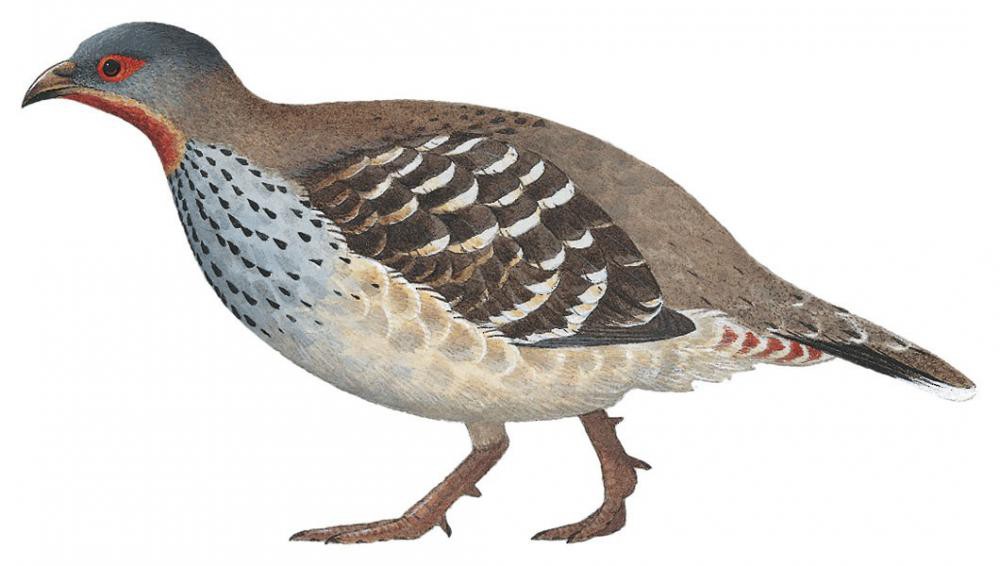Verreaux’s Partridge / Tetraophasis obscurus

Verreaux's Partridge
SCI Name:
Protonym: Lophophorus obscurus Nouv.Arch.Mus.Hist.Nat.Bull. 5 p.33 pl.6
Taxonomy: Galliformes / Phasianidae / Tetraophasis
Taxonomy Code: verpar1
Type Locality: 'Eastern Tibet,'' type from Mupin, Szechuan.
Author: Verreaux, J
Publish Year: 1869
IUCN Status: Least Concern
DEFINITIONS
TETRAOPHASIS
(Phasianidae; Ϯ Chestnut-throated Partridge T. obscurus) Genus Tetraogallus J. Gray, 1832, snowcock; Mod. L. phasis pheasant < Med. L. phasis avis pheasant; "TETRAOPHASIS OBSCURUS. MOU-PIN PHEASANT. LOPHOPHORUS OBSCURUS, J. Verr. Archiv. du Mus. Paris (1870), p. 35. HAB. Thibet (DAVID). THIS curious bird is one of the late discoveries of the French missionary Père David, and was described by M. Jules Verreaux, in the Archives of the Museum of Paris, as Lophophorus obscurus. It cannot be considered to belong to that genus, although in some characters it resembles its members, but represents an entirely new genus, and apparently connects a portion of the Phasianidæ with the Snow-Partridges or Tetraogalli. Nothing is known about its economy or habits." (Elliot 1871); "Tetraophasis Elliot, Monogr. Phasian., 1, 1871, p. xix, pl. [21] and text. Type, by original designation and monotypy, Lophophorus obscurus J. Verreaux." (Peters 1934, II, 62). This small group, formerly known as Monal Partridges, is confined to the mountains of central and southwestern China.
obscurum / obscurus
L. obscurus dark, dusky.
● ex “Hook-billed Green Creeper” of Latham 1782 (Akialoa).
● ex “Dusky-crowned Humming-bird” of Latham 1782 (syn. Clytolaema rubricauda).
● ex “Dusky Tody” of Latham 1782, and Pennant 1785 (syn. Contopus virens).
● ex “Pic verd de l’isle de Luçon” of Sonnerat 1776 (syn. Dendropicos griseocephalus).
● ex “Dusky Falcon” of Pennant 1787 (syn. Falco columbarius).
● ex “Dusky Grosbeak” (= ☼) of Pennant, 1784 (syn. Hedymeles ludovicianus).
● ex “Obscure Fly-catcher” of Latham 1823 (syn. Hemipus hirundinaceus).
● "44. PSITTACUS. ... obscurus. 3. P. macrourus niger, genis nudis, vertice cinereo-nigrescente vario, cauda cinerea. Hasselq. iter. 236. Habitat in Africa?" (Linnaeus 1758) (unident.: ?‡syn. Mascarinus mascarin).
● ex “White-rumped Woodpecker” of Latham 1782 (syn. Melanerpes erythrocephalus).
● ex “Tolocatzenatl” of Ray 1713, “Sturnus novae Hispaniae” of Brisson 1760, “Tolcana” of de Buffon 1770-1783, and “Brown-headed Stare” of Latham 1783 (subsp. Molothrus ater).
● ex “Dusky Rail” of Latham 1785 (syn. Pennula sandwichensis).
● ex “Dusky Fly-catcher” of Latham 1783 (Phaeornis).
● ex “Black and White Dobchick” of Edwards 1747, “Colymbus minor” of Brisson 1760, “Petit Grèbe” of d’Aubenton 1765-1781, pl. 942, and “Dusky Grebe” of Pennant 1785, and of Latham 1785 (syn. Podiceps auritus cornutus).
● ex “Dusky Plover” of Latham 1781 (cf. Dusky Bay, New Zealand) (Pluviorhynchus).
● ex “Dusky Petrel” of Latham 1785 (syn. Puffinus assimilis).
● ex “Indian Raven” of Willughby 1676, and “Wreathed Hornbill” of Latham 1781 (syn. Rhyticeros plicatus).
● ex “Dark Thrush” of Latham 1783 (Turdus).
● "This specimen, like many from the Anthony collection, is badly soiled, a condition which may have led Anthony to name a dark race" (Browning 1979) (syn. Vireo huttoni).
● "44. PSITTACUS. ... obscurus. 3. P. macrourus niger, genis nudis, vertice cinereo-nigrescente vario, cauda cinerea. Hasselq. iter. 236. Habitat in Africa ?" (Linnaeus 1758); "Linnæus identified his Psittacus obscurus with P. mascarinus, Briss. ... but the evidence is against this identification" (Salvadori 1891) (unident.; nom. dub.).
UPPERCASE: current genus
Uppercase first letter: generic synonym
● and ● See: generic homonyms
lowercase: species and subspecies
●: early names, variants, mispellings
‡: extinct
†: type species
Gr.: ancient Greek
L.: Latin
<: derived from
syn: synonym of
/: separates historical and modern geographic names
ex: based on
TL: type locality
OD: original diagnosis (genus) or original description (species)












